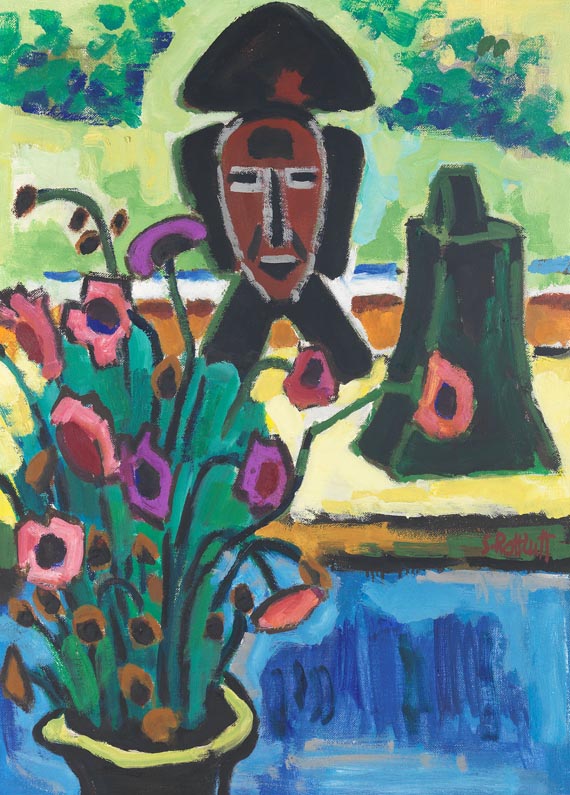
130
Karl Schmidt-Rottluff
Dunkles Symbol, 1964.
Olio su tela
Stima:
€ 90,000 / $ 104,400 Risultato:
€ 131,760 / $ 152,841 ( commissione inclusa)
Oil on canvas
Signed in right margin. Signed, titled and with work number "643" on stretcher. 91 x 65,5 cm (35,8 x 25,7 in)
PROVENANCE: Private collection South Germany.
Ketterer Kunst, auction 216, 2 June 1997, lot 72.
The painter, print-maker and sculptor Karl Schmidt was born in Rottluff near Chemnitz in 1884. In 1905 he enrolled to study architecture at the Dresden Technical University. The same year he met Ernst Ludwig Kirchner, Erich Heckel and Fritz Bleyl there, with whom he co-founded artist group known as 'Die Brücke' (The Bridge ). He outdid his colleagues in insisting on pure primary colors and his Expressionist paintings were dominated by forceful handling of the medium to achieve intensity and brilliance. Until 1912 Schmidt-Rottluff often stayed in the Dangastermoor near Varel in Oldenburg for quite some time, where he found a wealth of motifs for his landscape paintings. After moving to Berlin in 1911, he addressed himself to problems of form, developing an increasingly reductive geometric formal language. This development that was interrupted by the outbreak of the war. In 1918 he returned to Berlin. Stays in Pomerania, at Lake Leba in Ticino and in the Taunus Mountains as well as a stint in Rome to study at the German Academy in the Villa Massimo (1930) inspired his mature still lifes and landscapes. Stays in Pomerania, at Lake Leba in Ticino and in the Taunus Mountains as well as a stint in Rome to study at the German Academy in the Villa Massimo (1930) inspired his mature still lifes and landscapes. In 1937 his work was declared degenerate at the notorious Munich exhibition of 'Degenerate Art'. By 1941 he was forbidden to paint and was expelled from the painters' guild. After the second world war he was appointed to a chair at the (West) Berlin Hochschule für bildende Künste. In 1956, this renewer of art, who had begun as revolutionary in his youth, was awarded the 'Pour le Mérite' medal and felt honoured as a classic.
Karl Schmidt-Rotluff keeps his natural and creative strength up into an old age. His later works are coined by the same stringency of forms and colors as it is the case with works from an earlier period. He also kept his fascination for cultic art of primitive people, which had already played an important role in the early days of Expressionism. Following the period of Expressionism, Schmidt-Rottluff developed a linear –expressive painting style, which will consequently dominate his entire artistic creation. The strong contours, mostly kept in black, hint at the closeness to graphic art, and indeed, his watercolors are shaped by the same graphic basic concept. However, the unusually strong palette makes for something particular that goes far beyond the graphic composition. The rather two-dimensional composition of "Dunkles Symbol" (Dark Symbol) is transferred to three levels, in line with the old canon of fore-, middle- and background. In this case, however, without the usual spatial differentiation. It is just color and form that make for the picture’s effect.
The Brücke Museum, which was founded on his initiative, was inaugurated in Berlin in 1967. Numerous retrospectives in the Federal Republic paid tribute to this artist, who, as art historians unanimously agree, was one of the most important German Expressionists. The artist died in Berlin in 1976. [KD].
130
Karl Schmidt-Rottluff
Dunkles Symbol, 1964.
Olio su tela
Stima:
€ 90,000 / $ 104,400 Risultato:
€ 131,760 / $ 152,841 ( commissione inclusa)




 Lot 130
Lot 130